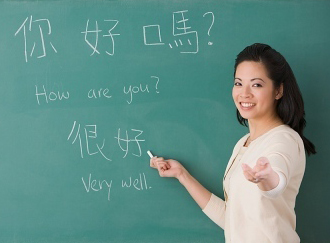Bi-lingualism is one of our distinguishing traits as Asian Americans. Most of us adult Asian Americans are comfortable switching back and forth between English and Mandarin, Cantonese, Hindi, Vietnamese, Korean, Tagalog or several dozen other languages and dialects.
Our bi-lingualism is an obvious cultural and professional asset, despite also being a source of stress in our lives.
As kids we worried that speaking another language in front of non-Asian friends would mark us as being different. Many of us hid our bi-lingual ability until we found ourselves among other Asian Americans, often not until we got to college.
Even as adults the simple act of speaking an Asian language opens us up to the annoyance of being seen as less than fully acculturated. Somehow Americans — the vast majority of whom are determinedly monolingual — can’t seem to grasp the fact that we can be fluent in another language while also knowing the arcane rules of football or being able to sing all the folk songs they learned in grade school. I guess it’s the price many Americans pay for growing up as such an insular majority!
As adults we come to cherish our bilingualism, possibly in direct proportion to the amount of stress it cost us growing up. We come to savor the bits of wisdom and cultural perception that went into the formation of each syllable of words that most of our fellow Americans can’t appreciate. I find a special thrill in discerning the apparently common roots shared by Korean or Chinese words and many words and phrases in the languages of Native Americans who, after all, are our distant cousins, having migrated from northeast Asia about 10,000 years ago.
I have spent hours trying to find support for my theory that Tahoe (the lake) may actually have been named by Chinese miners (dai hu — “great lake”), which seems closer than the Native American Washo tribe’s dá’o’ a ga, “edge of the lake” sometimes ascribed as the source. And anyone who has seen the tall pines at the summit of Mt. Pinos at the northern edge of Ventura County covered in snow will appreciate why I was astonished to learn that the Chumash called it Iwihinmu, which bears a dreamlike similarity to the Korean phrase uye hin namu (“white trees up above”).
On a more practical level our bilingualism allows us to serve as bridges between people from our ancestral homelands and American society. It’s a bridge badly in need of constant reinforcement because of the political and economic forces that persist in seeking to exploit prejudices and invoke an us-versus-them mentality that expands that vast blue moat between two great continents coming together to set the stage for the next millennium. Expanding such divides have always exacted a high cost in the march of civilization — as we should have learned from the horrible wars of the last century.
Cultivating an appreciation of the intimate thought processes of the cultures on both sides of a potential divide by promoting bilingualism is one way to ensure that the divide is bridged rather than transformed into a treacherous rift.
All things considered, perpetuating our bilingualism through our kids and through our nation’s educational and social policies may turn out to be the smartest investment we can make to secure a place in the global future taking shape today.

